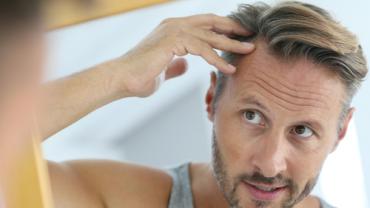
No one wants to experience hair loss (alopecia). This “crown of glory” is too closely allied to our level of self-confidence, positive self-image, and perceived youthfulness to be tampered with. Even if we must struggle with symptoms of ill health that affect other aspects of our physical appearance, panic seems to rise when our hair becomes the target.
As society’s general health continues to decline, hair loss becomes more prevalent, suggesting the hair’s growth cycle is intricately connected to our physiology. Nutrition and metabolic imbalances are surfacing as root causes of hair loss and should be considered when this symptom appears in patients. Moreover, hair loss is traditionally viewed as a male problem, but nearly 40 percent of sufferers are women, again indicating causes outside of the traditional “gender and genetics” stigma.
Hormones
Hormones are the most common cause of hair loss, with male pattern hair loss (MPHL) and female pattern hair loss (FPHL) being the most usual diagnoses. Both types of hair loss can be referred to as androgenetic alopecia (AGA) and are closely associated with imbalanced androgen levels. Testosterone converts to dihydrotestosterone (DHT) with the aid of the enzyme type II 5-alpha-reductace. DHT binds to receptors in the scalp follicles and diminishes their size, leaving thin, brittle hair that easily falls out. In men who sport higher levels of testosterone, this effect leads to balding. Women have less testosterone, making DHT less likely to leave them… ah hem… bald. However, when estrogen decreases (such as during menopause) androgen concentration naturally rises, leading to hair loss. Likewise, hyperandrogenic health conditions (such as occurs with PCOS), make thinning hair inevitable.
Stress
Either physiological or emotional stress can be the root cause of diffuse hair loss. A study of 99 adult male and female rhesus macaques sought to examine the relationship between hair loss and chronic hypothalamic–pituitary–adrenal (HPA) axis activity by measuring cortisol in hair. After excluding hair-plucking behavior, age, and body weight, results indicated that monkeys with greater than 30 percent hair loss showed higher levels of hair cortisol than did fully haired (hair loss less than 5 percent) monkeys. Further, hair cortisol levels highly correlated with the amount of hair loss in female monkeys. Hair cortisol has also been measured in humans and found to increase in response to stressful circumstances, confirming the association between stress and hair loss.
In previous mouse models stress caused hair loss by inducing neurogenic inflammation, adaptive immunity cytokine-imbalance characterized by a shift to Type 1 T-helper cell cytokines and increasing apoptosis of epithelial cells – all of which affect hair growth. This phenomenon was tested in 33 female medical students who underwent 3 stressful exam periods, 12 weeks apart. Compared to the control group, the test group showed significantly attenuated diurnal salivary cortisol rise indicating an attenuated HPA activity, and a decrease in cytokine production from T1 to T2 and a concomitant shift in cytokine balance toward predominance of TH1 cytokine expression. As expected, this group also showed a significant decrease in hair pigmentation and hair follicle regeneration between the stress and non-stress measurement points, further explaining how stress affects the life cycle of the hair follicle.
As chronic stress increasingly characterizes our modern lives, it must be considered in the rising prevalence of hair loss among women, especially.
Nutritional Factors
Hair loss associated with micronutrient deficiencies is not a new idea. In fact, even the layperson knows biotin as the “hair vitamin.” But even in the presence of a seemingly “healthy” diet, nutritional factors can play a role in hair loss.
Keratin, the primary protein in hair, is built from sulphur-containing amino acids, cysteine and methionine. Additionally, L-lysine resides within the hair root and keeps the follicle firmly planted in the skin integument. In a cross-sectional study of 100 participants, amino acid levels were compared with various types of hair loss. Histidine deficiency was seen in over 90% of participants with androgenic alopecia and 77.78% of participants with telogen effluvium (TE), while leucine deficiency was seen in 98.15% of participants with TE and 100% with FPHL. Alanine deficiency was observed in 91.67% of FPHL, 91.18% of MPHL, and 90.74% of TE.
Protein doesn’t just supply critical amino acids for hair growth. Iron deficiency is also common in women with hair loss and especially those with TE. A protein deficiency leaves hair fragile, brittle, and limp. Over time, hair follicles atrophy, leading to significant hair thinning. It is crucial to consider potential protein inadequacies when faced with a case of hair loss. Inadequate protein may be prominent among individuals consuming a vegan or vegetarian diet, young women with eating disorders, individuals on strict diets or reduced calorie plans, athletes, elderly, and those experiencing chronic stress. Several health conditions deplete protein reserves, making a high protein diet plan essential for those who are healing and experiencing comorbid hair loss.
As an additional consideration, diets high in simple sugars and carbohydrates, leading to insulinemia can increase hair loss. Insulin contributes to the synthesis of androgens, but specifically increases DHT concentrations in the hair follicle. Therefore, when hair loss exists with metabolic imbalances, nutritional changes are a top consideration for controlling hair loss.
Hormones, stress, and nutritional factors are just a few of the initial considerations when determining the root cause of hair loss. Rarely is it a solo symptom, but rather a sign of a much deeper metabolic, hormone, or nutritional dilemma.